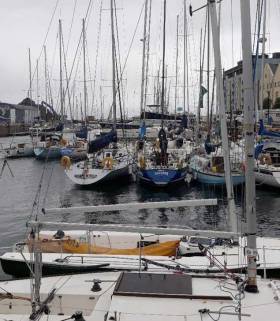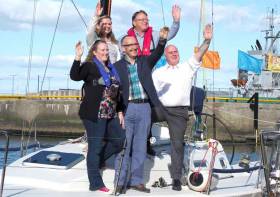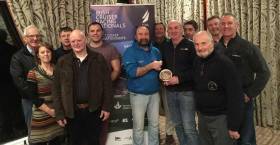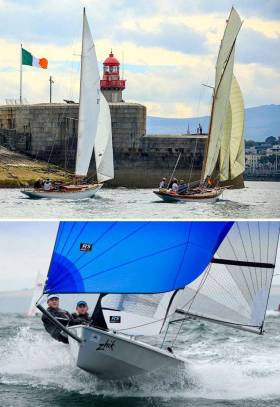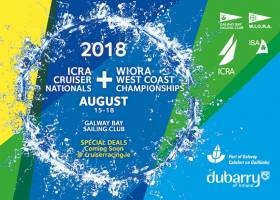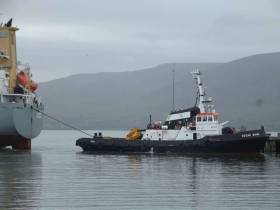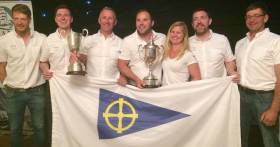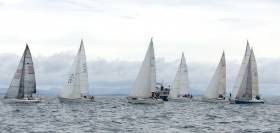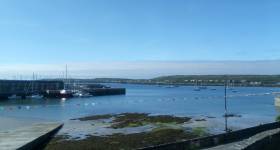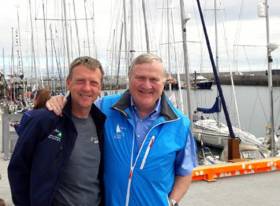Displaying items by tag: WIORA
First WIORA Races Postponed Due to Gales on Galway Bay
There was a disappointing start to today's WIORA sailing championships with the postponement of the much-anticipated races due to strong winds on Galway Bay.
A 54-boat fleet was scheduled to race two races this morning but the Skippers Briefing at the Harbour Hotel at Galway Docks heard from International Race Officers Alan Crosbie and David Lovegrove that winds were gusting to 32-knots and the races would be postponed on safety grounds. See the vid of the briefing below that explains the difficulties faced by the race team.
Galway Bay Sailing Club organisers are now preparing for the first race of the 2018 ICRA Championships tomorrow morning with an extended programme over six hours.
Galway Way Bay Sailing Club Launch ICRA & WIORA 2018
This week Galway Bay Sailing Club (GBSC) members and friends gathered at Dock 1 Seafood Bar and restaurant in Galway Harbour for the official launch of the ICRA/WIORA 2018 which will be held in Galway Harbour from August 15th – 18th.
On a gloriously sunny Summer solstice evening the event chairman, Event organiser Martin Breen, kicked off proceedings by confirming how important it is for GBSC to host a national regatta in the Galway Docks.
Martin mentioned that GBSC has had a very sombre beginning to the season with the loss of longtime members Henry Lupton and David Fitzgerald. Even though of different generations, they were like-minded in their promotion of sailing and their exploits have been well documented on ‘Afloat’ie. It was their peers who wrote the constitution of GBSC which includes the club goal of ‘promoting the sport of Sailing on Galway Bay’ and it is within this goal that we sought the hosting of the 2018 ICRA National Championships.
"Please judge us in GBSC on how we contributed to promoting the sport of sailing on Galway Bay"
GBSC are really looking forward to providing the best of Galway hospitality ashore and the best of race management afloat, as the National Championships in any sport deserves.
Even though entries received to date are already in excess of entries to recent National Championships, GBSC says they do not consider this to be a benchmark of the success of the event. "Rather, after the Championships and when we begin to reflect on this season past about the time of the Autumn equinox, please judge us in GBSC on how we contributed to promoting the sport of sailing on Galway Bay".
WIORA Votes to Suspend Membership Fees for 2018
The Annual General Meeting of the 2017 West of Ireland Offshore Racing Association (WIORA) took place at the Dromoland Inn in Co. Clare earlier this week. Among the items discussed on the night was the combined 2018 WIORA ICRA Championships which will be run in Galway Bay next August. In acknowledging that combining events can mean an increase in costs to boat owners and participants, and as a gesture of goodwill and thanks to its members for their continued support, WIORA have voted to suspend membership fees for 2018. The venue for the 2019 West Coast Championships was also decided at the AGM with Foynes Yacht Club being awarded the event.
After twelve years in his role as Honorary Secretary of the Association, Thomas Whelan from the Royal Western Yacht Club of Ireland, stepped down at the AGM. WIORA Commodore, Simon McGibney, the WIORA committee and its members would like to sincerely thank Thomas for all his years of service and contribution to promoting cruiser racing along the west coast and wish him the very best of luck with his new found free time next year.
2017 – A Very Irish Sailing Season
While sailing is now a year-round interest, and for many a year-round activity too, the notion of a traditional season is natural for anyone who lives in Ireland. Admittedly, there are times when we seem to be experiencing the four annual climatic seasons in just one day. But this sense of a seasonal change, and the appropriate alterations in activity which accompany it, are in our genetic makeup. And though marinas and the Autumn Leagues which they facilitate have pushed the season’s end back to the October Bank Holiday Weekend, for many, that’s it. It’s finally time for boats to be rested and energies deployed in other ways. W M Nixon reflects on highlights of the year.
These times we live in, they tend to emphasise big events – celebrity happenings you might call them – and our perceptions of a season past may be skewed by how the major fixtures played through. But your true Irish sailing season has at its core the classic club programme from April to October, with its plethora of weekend and weekday evening events. If you want to sense the beating heart of our sailing, you have to take the pulse of this local and club scene.
We know it’s not for everyone. Some dinghy crews only emerge for major regional and national championships. But week in, week out, it’s the regular local sailing, from the smallest club right up to the majestic programme of Dublin Bay Sailing Club, which sets the tone for the majority of sailors.
 Week in, week out, Dublin Bay Sailing Club provides a comprehensive programme of local racing from the end of April until the end of September, and it has been successfully doing so since 1884. Here the club's Beneteau 31.7s, one of DBSC's largest one design keelboat fleets negotiate a weather mark at the class championships Photo David O’Brien/Afloat
Week in, week out, Dublin Bay Sailing Club provides a comprehensive programme of local racing from the end of April until the end of September, and it has been successfully doing so since 1884. Here the club's Beneteau 31.7s, one of DBSC's largest one design keelboat fleets negotiate a weather mark at the class championships Photo David O’Brien/Afloat
And for those who sailed regularly all through the time-honoured season, it has to be admitted that weatherwise, we experienced a very mixed bag. As we shall see, there were brief periods of good weather which blessed some events. But in any case, one dyed-in-the-wool cub sailor firmly told us that as far as he was concerned, it was a very good season.
“For sure, there was rain and wind,” he said. “But we need wind for sailing. If you get a long period of rain-free weather, the evenings are likely to be wind-free as well. Frankly I’d rather get a good race in rain than sit becalmed on a perfect summer’s evening. But as we’re an east coast club, we often get that east coast effect of Atlantic weather without Atlantic rain, which is ideal for club racing. By and large, it has been a good sailing season, and race management seems to be improving all the time. So 2017 is going to go down as a good year for club sailing, but only a very average year for sunshine”.
As for Irish sailing’s national structure, inevitably there’s a clashing of events. There is only a finite number of weekends available at peak season when different big ticket regattas and championships hope to be staged, but as well, each club and area quite rightly expect to bring prestigious fleets to its part of Ireland.
However, in 2017 there was increasing emphasis at official club level on making sailing fun again. We’d begun to take it too seriously, something reinforced by the grim years of the recession, and then the winning in 2016 of Annalise Murphy’s Silver Medal at the Olympics in Rio.
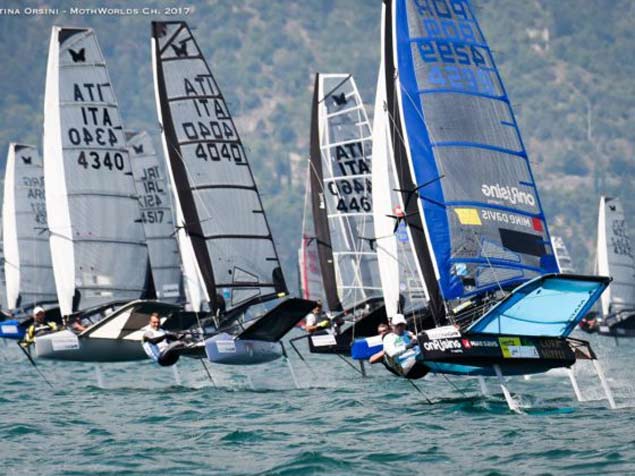 Olympic Silver Medallist Annalise Murphy led the way in signalling a change of mood for 2017 after the seriousness of her 2016 campaign towards success in Rio. In the early part of the season, she concentrated on the International Foiling Moth, and in this 223-strong fleet at the Worlds on Lake Garda in May, she became the Women’s World Champion. She is currently on a completely different direction for ten months on the Volvo Ocean Race as a crewmember on the One-Design Volvo Ocean 65 Turn the Tide on Plastic
Olympic Silver Medallist Annalise Murphy led the way in signalling a change of mood for 2017 after the seriousness of her 2016 campaign towards success in Rio. In the early part of the season, she concentrated on the International Foiling Moth, and in this 223-strong fleet at the Worlds on Lake Garda in May, she became the Women’s World Champion. She is currently on a completely different direction for ten months on the Volvo Ocean Race as a crewmember on the One-Design Volvo Ocean 65 Turn the Tide on Plastic
Of course the winning of Annalise’s medal was a matter for fun-filled celebration once it had happened, but the buildup to it was deadly serious, and that affected the tone of the national sailing mood in every area. But with the Medal in the bag, 2017 could reasonably expect to have a lighter mood, and this in turn helped us to adjust to an over-crowded programme, as crews could plan on a series of campaigns which balanced between serious events which provided proper championship results of national significance, and events which officially claimed to be providing everyone with a good time, even if some crews raced with deadly seriousness.
Either way, so much was going on that a review like this can only hope to give an impression of the season rather than a detailed analysis, but we’ll try to give it a comprehensible shape by listing the main events of Irish interest at home and abroad under either the “serious” or “fun” categorisations:
March/April: Intervarsity Championships – serious, UCD selected to represent Ireland
April: Irish Sailing Youth Pathway Nationals, Ballyholme - serious (and impressive), Ewan McMahon the star, Rush SC prominent in success
 The hyper-busy J/109 Mojito managed a hard-fought overall win in the ISORA Championship, successful participation in the Rolex Rastnet Race, and a second place in the Dun Laoghaire to Dingle Race.
The hyper-busy J/109 Mojito managed a hard-fought overall win in the ISORA Championship, successful participation in the Rolex Rastnet Race, and a second place in the Dun Laoghaire to Dingle Race.
April: Season-long ISORA Championship get under way, several venues – inevitably serious. In due course, J/109 Mojito (Peter Dunlop & Vicky Cox, Pwllheli SC) has very close overall win – despite taking time out to do the Fastnet
May: Scottish Series at Tarbert– serious, Pat Kelly’s J/109 Storm and Stephen Quinn’s J/97 Lambay Rules top their classes.
June: Howth Lambay Weekend – Fun
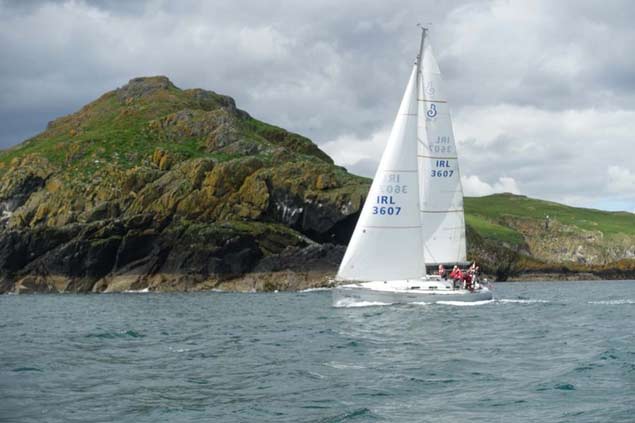 It could be a remote part of the West Coast, but Howth Yacht Club’s annual Lambay Race is a reminder that Ireland’s least-spoilt coastline is on an East Coast island. Photo courtesy HYC
It could be a remote part of the West Coast, but Howth Yacht Club’s annual Lambay Race is a reminder that Ireland’s least-spoilt coastline is on an East Coast island. Photo courtesy HYC
June: ICRA Nationals Royal Cork – probably the most serious of them all. John Maybury’s J/109 Joker 2 RIYC), Ross MacDonald’s X332 Equinox (HYC), and Paul Gibbons’ Anchor Challenge (RCYC) win the three main classes.
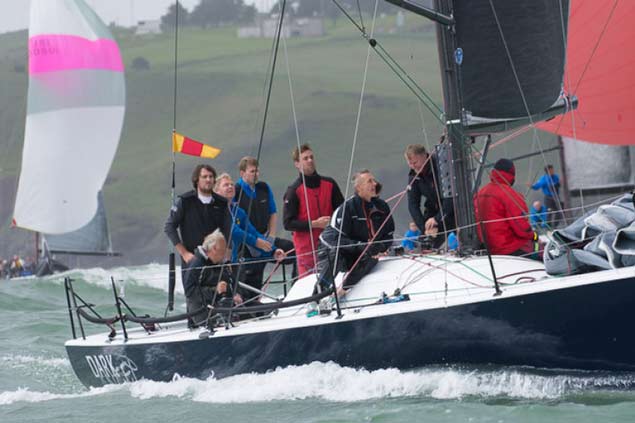 Rob O’Leary racing the Dubois 36 Dark Angel from South Wales to class success in the ICRA Nats at Crosshaven. Photo: Robert Bateman
Rob O’Leary racing the Dubois 36 Dark Angel from South Wales to class success in the ICRA Nats at Crosshaven. Photo: Robert Bateman
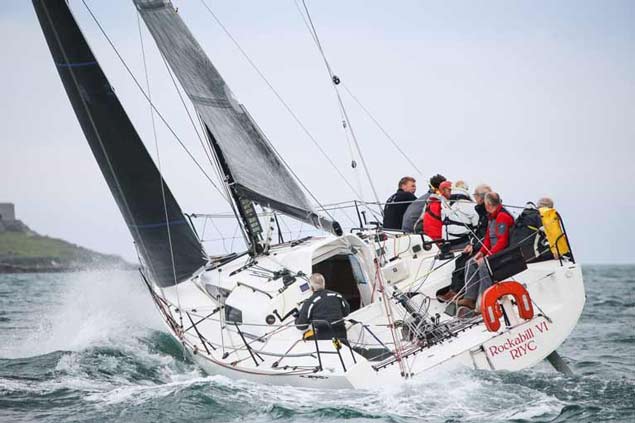 Paul O’Higgins’ JPK 10.80 Rockabill VI shortly after the start of the very tough Dun Laoghaire to Dingle Race, which she won, while a sister-ship Bogatyr was also winner of the likewise rough 608-mile Rolex Middle Sea Race in late October. This photo goes some way to revealing the reason for the JPK 10.80’s success – she is only 35ft LOA, yet you’d think you’re looking at a significantly larger boat. Photo: David O’Brien/Afloat.ie
Paul O’Higgins’ JPK 10.80 Rockabill VI shortly after the start of the very tough Dun Laoghaire to Dingle Race, which she won, while a sister-ship Bogatyr was also winner of the likewise rough 608-mile Rolex Middle Sea Race in late October. This photo goes some way to revealing the reason for the JPK 10.80’s success – she is only 35ft LOA, yet you’d think you’re looking at a significantly larger boat. Photo: David O’Brien/Afloat.ie
June: National YC Volvo Dun Laoghaire to Dingle Race – serious
June: Sovereign’s Cup at Kinsale – fun
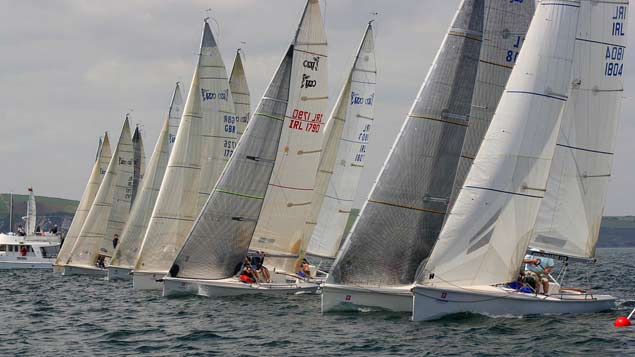 By maintaining its position as a standalone event, the Sovereign’s Cup at Kinsale can invite non-IRC classes to compete, and the 1720s responded with this keen turnout. The overall winner across all classes was adjudged to be Rob McConnell’s A35 Fool’s Gold from Dunmore East. Photo: Robert Bateman
By maintaining its position as a standalone event, the Sovereign’s Cup at Kinsale can invite non-IRC classes to compete, and the 1720s responded with this keen turnout. The overall winner across all classes was adjudged to be Rob McConnell’s A35 Fool’s Gold from Dunmore East. Photo: Robert Bateman
June: Dinghyfest at Royal Cork – brilliantly balanced mixture of serious & fun
July: Volvo Dun Laoghaire Regatta – superb, and fun
July: WIORA Championship at Aran Islands – unique
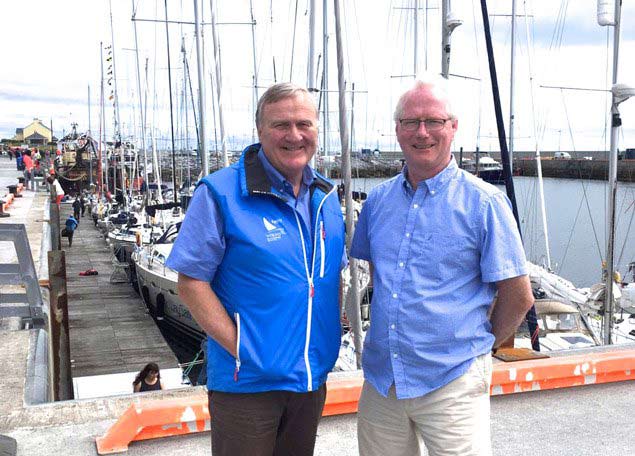 WIORA Nationals 2017 – and first time at the Aran Islands. Irish Sailing President Jack Roy (left) with WIORA organiser Cormac Mac Donncha. The popular Irish Sailing President seemed to have several doppelgangers, as that same evening he was present at the Opening Ceremony for the Volvo Dun Laoghaire Regatta, in which he also served for the entire four days as a Race Officer.
WIORA Nationals 2017 – and first time at the Aran Islands. Irish Sailing President Jack Roy (left) with WIORA organiser Cormac Mac Donncha. The popular Irish Sailing President seemed to have several doppelgangers, as that same evening he was present at the Opening Ceremony for the Volvo Dun Laoghaire Regatta, in which he also served for the entire four days as a Race Officer.
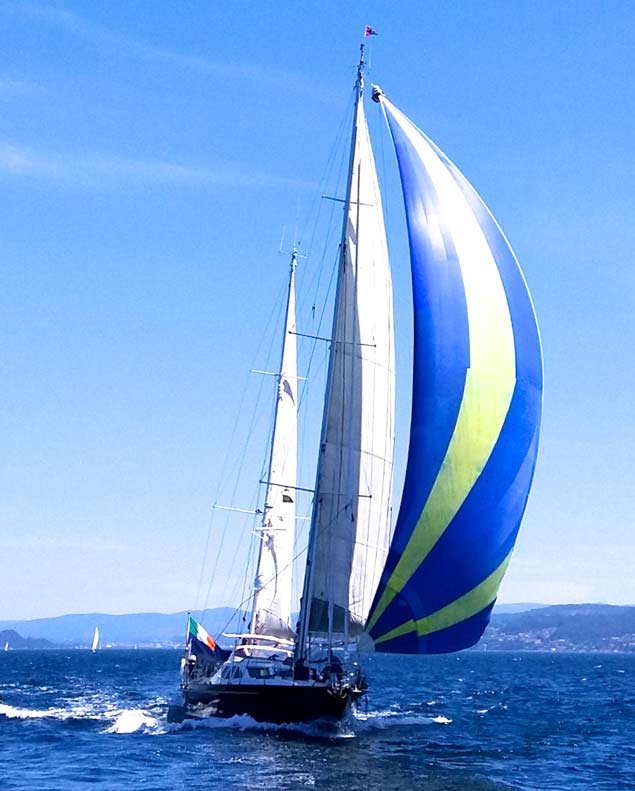 With more than sixty boats taking part, the Irish Cruising Club Rally in Northwest Spain was an outstanding success. This is Michael Holland’s 70ft 1993-built Dubois ketch Celtic Spirit – a veteran of Arctic and Antarctic cruising - making knots down the coast of Galicia. Photo: Trish Phelan
With more than sixty boats taking part, the Irish Cruising Club Rally in Northwest Spain was an outstanding success. This is Michael Holland’s 70ft 1993-built Dubois ketch Celtic Spirit – a veteran of Arctic and Antarctic cruising - making knots down the coast of Galicia. Photo: Trish Phelan
July: Irish Cruising Club Rally in Northwest Spain – seriously well organised, great fun to take part
July: Glandore Classics – fun, yet serious too
August: Rolex Fastnet Race from Cowes – serious
 Fastnet Rock astern for Jedi, the Irish National Sailing School’s successful J/109, which won class IRC 3B in the Fastnet Race, and also the Roger Justice Trophy for the top-placed Sailing School boat. Jedi is one of the 15-plus class of hotly-raced J/109s in Dun Laoghaire, whose annual championship was won by the Kelly family’s Storm from Rush SC and Howth, while the most successful boat in other events was John Maybury’s Joker 2.
Fastnet Rock astern for Jedi, the Irish National Sailing School’s successful J/109, which won class IRC 3B in the Fastnet Race, and also the Roger Justice Trophy for the top-placed Sailing School boat. Jedi is one of the 15-plus class of hotly-raced J/109s in Dun Laoghaire, whose annual championship was won by the Kelly family’s Storm from Rush SC and Howth, while the most successful boat in other events was John Maybury’s Joker 2.
August: Calves Week from Schull – prides itself on being a neat balance between fun and “quite serious racing”, and succeeds in being so.
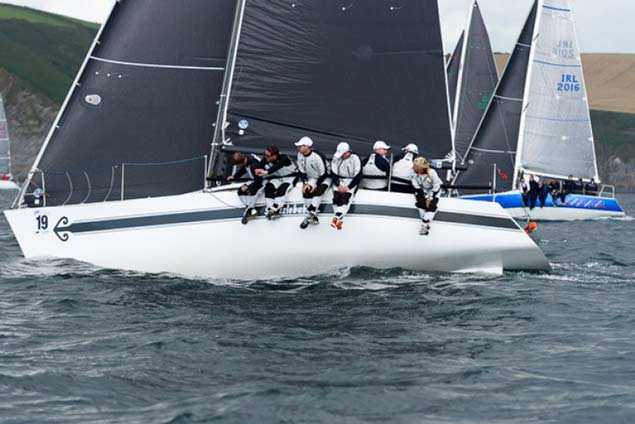 Everybody likes her, even if she beats them all. The characterful Swuzzlebubble racing to success in the Half Ton Classics at Kinsale. Photo: Robert Bateman
Everybody likes her, even if she beats them all. The characterful Swuzzlebubble racing to success in the Half Ton Classics at Kinsale. Photo: Robert Bateman
August: Half Ton World Classics at Kinsale: Supposedly serious, but in the ultimate lotus-eating venue and with such an extraordinary selection of boats, it couldn’t help but be fun. And everyone likes the slightly eccentric overall winner, the legendary Swuzzlebubble
August: Crinnui na mBad, Kinvara – traditional and fun
 The annual Crinnui na mBad at Kinvara in August may not have been favoured with good weather, but it was as popular as ever. This is one of the winners, John Flaherty’s Galway hooker Naomh Cailin, going out to race. Photo: Pierce Purcell
The annual Crinnui na mBad at Kinvara in August may not have been favoured with good weather, but it was as popular as ever. This is one of the winners, John Flaherty’s Galway hooker Naomh Cailin, going out to race. Photo: Pierce Purcell
August: Laser Nationals Royal Cork YC – serious
 RCYC Admiral John Roche, 2017 National Champion Finn Lynch (NYC) and Mark Whisker of sponsors Volvo at the prize-giving for the Volvo Laser Nationals at Crosshaven. Photo: Robert Bateman
RCYC Admiral John Roche, 2017 National Champion Finn Lynch (NYC) and Mark Whisker of sponsors Volvo at the prize-giving for the Volvo Laser Nationals at Crosshaven. Photo: Robert Bateman
September: Autumn League at Howth – fun event, but run with such serious efficiency that they’d a full programme completed after six weekends despite losing two days of racing to the late season’s poor weather.
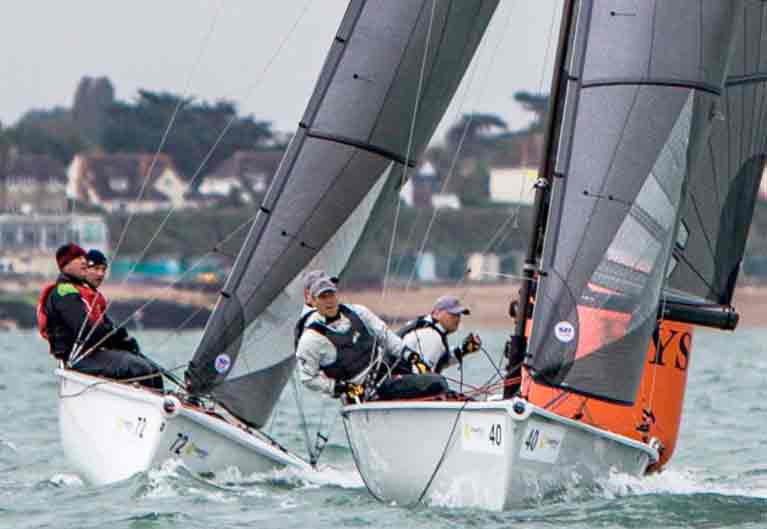 Royal St. George's Michael O'Connor, Davy Taylor and Ed Cook – SB20 'Corinthian' World Champions and Irish Champions
Royal St. George's Michael O'Connor, Davy Taylor and Ed Cook – SB20 'Corinthian' World Champions and Irish Champions
September: The SB 20 Nationals, incorporated into the first weekend of the Howth Autumn league as a three-day separate championship, had extra interest as it included recently-crowned SB 20 Corinthian World Champions Michael O’Connor, Davy Taylor and Edward Cook of Royal St George YC, who had won in the Worlds at Cowes. They added the Irish title to their 2017 trophy list.
October: Autumn League at Royal Cork - fun
October: Mini-Transat at La Rochelle – serious
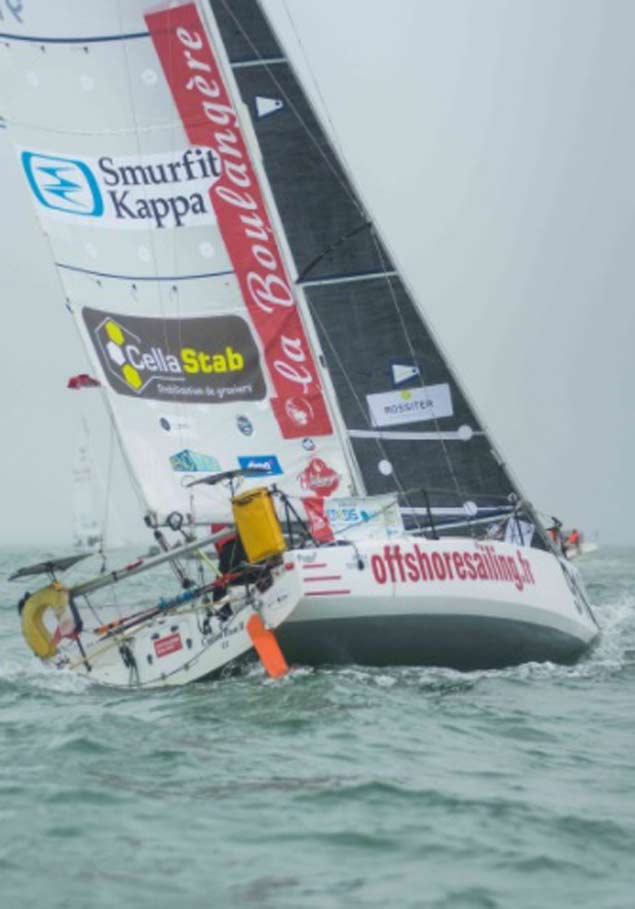 Ireland’s Tom Dolan in the first leg of the Mini-Transat 2017, 1,400 miles from La Rochelle to Las Palmas. He finished this stage 12th in a class of 55 boats The second Transatlantic stage starts on 1st November
Ireland’s Tom Dolan in the first leg of the Mini-Transat 2017, 1,400 miles from La Rochelle to Las Palmas. He finished this stage 12th in a class of 55 boats The second Transatlantic stage starts on 1st November
October: Junior All-Ireland at Schull – serious
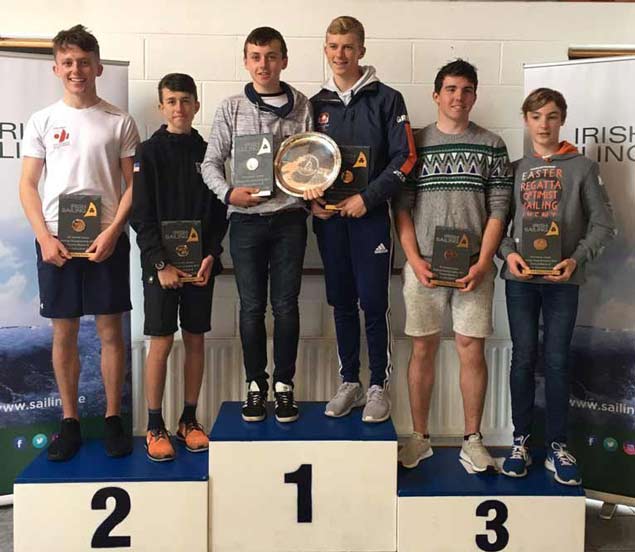 Junior All-Ireland winners on the podium. Kinsale YC’s champions Michael O'Suilleabhain and Michael Carroll, with second placed Rian Geraghty-McDonnell and Harry Durcan (RCYC) and Loghlen Rickard and Nathan Van Steenberge third. Photo: Robin Bateman
Junior All-Ireland winners on the podium. Kinsale YC’s champions Michael O'Suilleabhain and Michael Carroll, with second placed Rian Geraghty-McDonnell and Harry Durcan (RCYC) and Loghlen Rickard and Nathan Van Steenberge third. Photo: Robin Bateman
October: Senior All-Ireland Sailing Championship at Mullingar – serious and historic, as it is staged at one of the smallest, most rural clubs in the country, and raced in GP 14s.
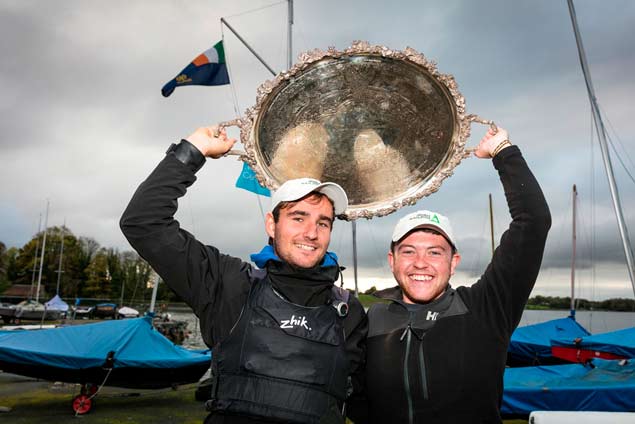 Fionn Lyden of Baltimore, All-Ireland Champion 2017, at Mullingar with the famous silver salver with crewmate Liam Manning of Schull. Photo: David Branigan/Sailing Ireland
Fionn Lyden of Baltimore, All-Ireland Champion 2017, at Mullingar with the famous silver salver with crewmate Liam Manning of Schull. Photo: David Branigan/Sailing Ireland
October: Student Yachting Worlds in Marseilles in France – serious. Ireland – a winner in times past –places fifth this time round.
October: Rolex Middle Sea Race from Malta – serious
October: Volvo Ocean Race from Alicante – serious
This fun/serious differentiation seems to have been supported by our wayward climate, which often managed to come up with good weather just when it was needed for the fun events, yet it achieved this in the midst of a generally very unsettled and often plain inclement summer.
The photos are all that is needed to show how this was so during 2017’s premier event, the Volvo Dun Laoghaire Regatta 2017 from July 6th to 9th. It wasn’t a sun-blasted regatta, but it wasn’t a wind-blasted one either – it was just a brief period of exceptionally pleasant warm weather with enough breeze for good racing , yet not too much wind to make it difficult to provide the in-harbour finishes which were introduced in special acknowledgement of the fact that they were also celebrating the Bicentenary of the massive work starting on the construction of this truly monumental and architecturally magnificent artificial port.
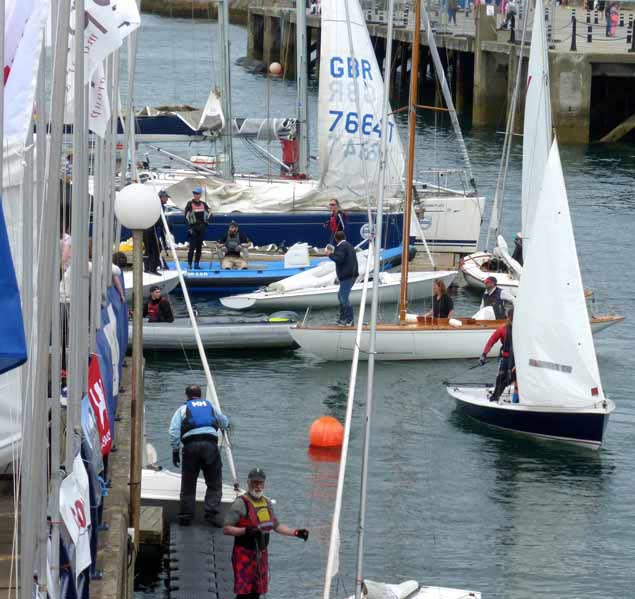 Piling them in – the good-humoured yet busy atmosphere off the National YC slipway after another day of racing in the Volvo Dun Laoghaire Regatta. Photo: W M Nixon
Piling them in – the good-humoured yet busy atmosphere off the National YC slipway after another day of racing in the Volvo Dun Laoghaire Regatta. Photo: W M Nixon
With 34 classes racing and boat numbers pushing towards the 500 mark, obviously it would have been totally inappropriate to try to include the ICRA Nats within it, as some have suggested. But even with such good conditions in its relaxed form, it could easily have got out of hand. However, with Organising Committee Chairman Tim Goodbody apparently yet always very quietly here, there and everywhere to ensure that all was running smoothly with a skillfully delegated team, it ran like clockwork to round out his two year stint in the top role with considerable style and success.
One noted visiting crew enthused that it was the best four days of sailing they’d ever had, and that was before they became aware that they’d won the ultimate trophy, the Kingstown 200 Cup, complete with a hundred guinea purse and a framed picture of the first regatta ever staged in what is now Dun Laoghaire, the Kingtown Regatta of 1828.
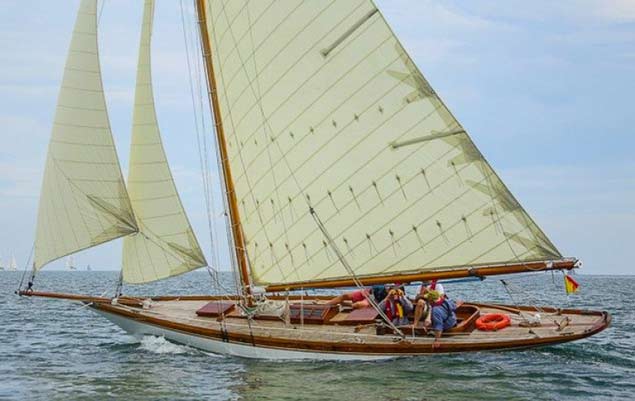 The sweetest boat in the fleet – Myfanwy from Wales - racing in the Volvo Dun Laoghaire Regatta. Photo: David O’Brien/Afloat.ie
The sweetest boat in the fleet – Myfanwy from Wales - racing in the Volvo Dun Laoghaire Regatta. Photo: David O’Brien/Afloat.ie
That was Rob Mason and his shipmates from Milford Haven with the classic 37ft Alexander Richardson-designed 1897-built gaff cutter Myfanwy, which Rob restored himself and sailed to Dun Laoghaire for the newly-introduced Classics Division, which was supposedly a one-off gesture to the Bicentenary.
But it worked so well that there’s talk of repeating it in 2019. Be that as it may, after the last race I was commiserating with the the Myfanwy team on their final placing, as I thought they’d sailed well enough to be comfortably on the podium, but Performance Echo decided others. Maybe they sailed too well. Yet far from being disappointed, they were on top of the world, and then when they went along to the huge prize-giving at the Royal St George, it was to hear to their complete surprise that the much-admired Myfanwy had been awarded the Kingstown 200 Cup and the prize purse and the historic picture……
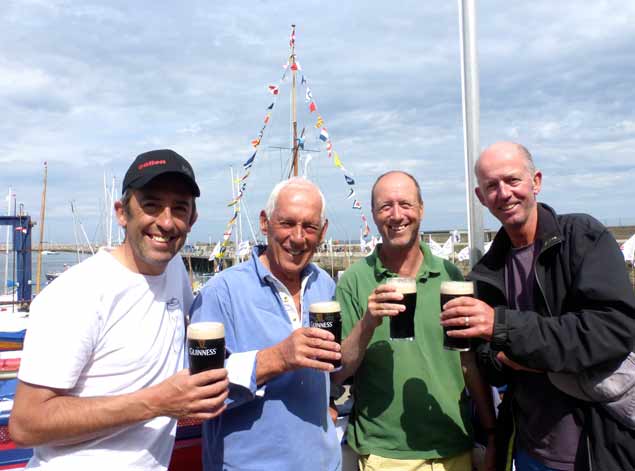 Before and after. Myfanwy’s crew celebrating “four days of the best sailing we’ve ever had” immediately after coming ashore at the conclusion of the final race in the Volvo Dun Laoghaire Regatta 2017. They are (left to right) Max Mason, his father Rob who restored Myfanwy, Andy Whitcher, and Gus Stott. The photo below shows them genuinely gobsmacked after finding they’d won the big trophy and its associated prizes. Photos W M Nixon and Gareth Craig/Fotosail
Before and after. Myfanwy’s crew celebrating “four days of the best sailing we’ve ever had” immediately after coming ashore at the conclusion of the final race in the Volvo Dun Laoghaire Regatta 2017. They are (left to right) Max Mason, his father Rob who restored Myfanwy, Andy Whitcher, and Gus Stott. The photo below shows them genuinely gobsmacked after finding they’d won the big trophy and its associated prizes. Photos W M Nixon and Gareth Craig/Fotosail

This classics success reflected a good year for the classic boats in Ireland, as six of the Howth Seventeens (1898) and a dozen of the Water Wags (1887 & 1900) made their way to the famous Sailing Week in the Morbihan in southern Brittany in May. Then at the end of July, the newest Howth 17s, Orla built in France for Ian Malcolm by the famous Skol ar Mor, arrived home, and in an epic effort in late August, in honour of Class President Hal Sisk, the continually reviving Water Wags managed their first turnout of more than thirty boats for their traditional Wednesday evening racing.
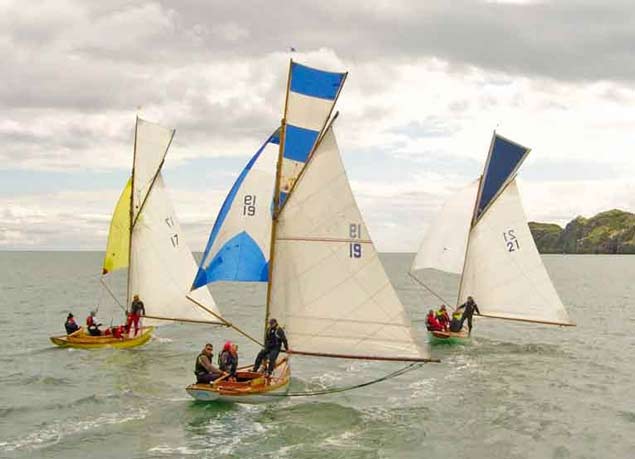 Howth Seventeens racing in their annual championship with Ireland’s Eye beyond – the new boat Orla (no 21) is on the right. Photo: Neil Murphy
Howth Seventeens racing in their annual championship with Ireland’s Eye beyond – the new boat Orla (no 21) is on the right. Photo: Neil Murphy
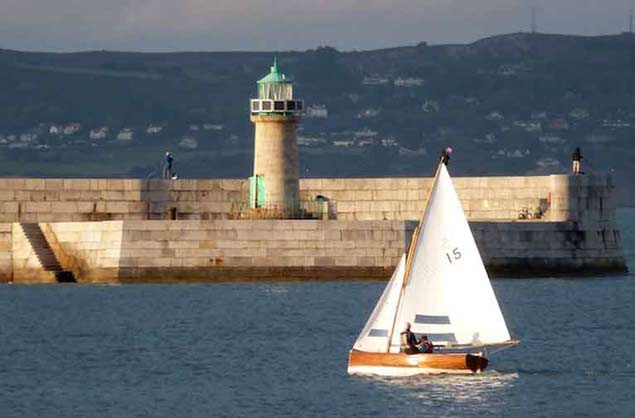 With a history going back to 1887, the Water Wags became an overnight success at the end of August when they finally managed a turnout of more than 30 boats. The clear winners were David & Sally MacFarlane with No 15 Mousmie, aged 107 years. Photo W M Nixon
With a history going back to 1887, the Water Wags became an overnight success at the end of August when they finally managed a turnout of more than 30 boats. The clear winners were David & Sally MacFarlane with No 15 Mousmie, aged 107 years. Photo W M Nixon
This has inevitably only been a skim across the events of 2017. An extraordinary season. Many hoped at the beginning of the year that it would see some relaxation after the intensity of the Olympic year, and while that may have been the overall mood, the achievements recorded above show that some sailors continued to take their own sailing very seriously indeed.
That is as it should be. But if I had to select a photo which captures the mood of 2017, the determination to make the best of it whatever the weather, then the Thomas Gautier image of Aoife Hopkins in devil-may-care mood, flying over a big sea off Douarnenez in Brittany on her way to winning the Laser Radial Under 21 European Championship, would undoubtedly be it. At that moment, Aoife was sailing for all of us.
 Sailing for all of us. Aoife Hopkins in devil-may-care style, on her way to winning the Laser Radial U-21 Euros at Douarnenez in July. Photo: Thomas Gautier
Sailing for all of us. Aoife Hopkins in devil-may-care style, on her way to winning the Laser Radial U-21 Euros at Douarnenez in July. Photo: Thomas Gautier
Galway Bay Confirmed As Hosts Of 2018 ICRA Nationals
#ICRA - The Irish Cruiser Racing Association has reaffirmed its decision to allocate the 2018 ICRA National Championships to the West of Ireland Offshore Racing Association (WIORA) and Galway Bay Sailing Club.
The event from 16-18 August 2018 will be run in conjunction with the 2018 WIORA West Coast Championships from 15-17 August.
This marks the Galway Bay Sailing Club’s first time hosting the ICRA Nationals, which were held at the Royal Cork this past summer, and members will be eager to show off their club’s revamped facilities in Galway Docks.
Reduced early entry fees with free cranage and berthage, accommodation packages, details of two prizegiving parties, the Notice of Race and entry form will be made available shortly, according to the GBYC.
I’m wondering why Government officials, the civil servants, don’t listen to advice from people who know more than they do about the maritime sphere…..
Two issues which cause concern are the contradictory attitude of the Department of the Marine which, on the one hand proclaims the importance of the blue economy and pushes the Ocean Wealth Plan as evidence of its maritime commitment, but on the other hand – denies that fish in Irish waters are a natural resource which Ireland owns … Hard to believe perhaps, but that is what the Department has said and a leading maritime lawyer challenges it, as you’ll hear on the Podcast.
The second issue is maintaining the communities on our offshore islands where there is a belief that the Government is not helping sufficiently … President Higgins agrees with them and in the Podcast you’ll hear the Islands’ Federation point to the success of WIORA held on the Aran Islands and a shipping achievement for Bere Island as evidence of what the islands can do.
Listen to the Podcast here
Tribal Crew Are Aran Islands WIORA 2017 Champions
The WIORA Championships concluded yesterday in the Aran Islands. First gun time was delayed on the final day to 1155 to allow competitors to see the Lions match before heading out racing. The forecasted light winds thankfully didn’t materialise and racing took place in beautiful sunshine with about 10–kts south westerly breeze in a race area just north of the islands.
In IRC One, Liam Burke’s Farr 31 Tribal fought off a late challenge by Glen Cahill’s Joie de Vie to close out a perfect result with five bullets with Lauren Heskin’s Now What in third. In ECHO One, renowned Galway man, Enda O’Coineen on Kilcullen Flyer managed to steal Tribal’s glory by clinching victory in the last race of the series with Adrian O’Connell’s Hero from the Royal Western Yacht Club in third.
In the light breeze Johnny Callanan’s Corby 25, Stonehaven Racing dominated the race course finishing well ahead of the competition to secure a hard fought championship beating Ian and Ann Gaughan from Mayo Sailing Club’s Xena and Aidan Breen’s Port of Galway for the podium places in both IRC and ECHO Two.
Despite the series already secured by Brian Raftery on Gossip from Sligo Yacht Club, the battle between the two J24’s continued with Martin MacNamara’s Gala Racing finding their form to take the win in the last race. Conn Lavelle’s Movita sailed a consistent series to secure third overall. In ECHO Three Gala Racing finished in first place ahead of Aine Nolan’s Rhocstar with Gossip in third.
Frankie Leonard’s Roamar secured his second win of the event and first overall in White Sails ahead of Owen Cunningham’s Woofer and Cormac MacDonncha, the main organiser of the event, in third.
The overall winner of the Volvo West Coast Championship from across all IRC classes was Liam Burke’s Tribal from Galway Bay Sailing Club.
Joie de Vie Leads WIORA Class One After Round Aran Islands Coastal Race
Day three of the Volvo WIORA Coast Championships continued off the Aran Island of Inís Mór with the Coastal Race with racing taking place around the spectacular cliffs of the Aran Islands, in fantastic conditions, through the Gregory Sound and in towards the mainland. The 10-12kt northerly breeze provided perfect conditions to surf down the Atlantic swell back through Foul Sounds for Classes 2 and White Sails and South Sound for classes 1 and 2.
With rocky shores, sandy beaches and a myriad of lobster pots to be negotiated it provided a challenging days racing and quite a contrast to the previous day’s windward leewards.
In IRC 1 Tribal has been knocked off the top of the leaderboard by Glen Cahills’ Joie de Vie sailing a very impressive race. In IRC 2 Stonehaven Racing are holding onto first position while in IRC 3 J24 Gossip from Sligo Yacht Club are continuing their good run and with just one race scheduled for tomorrow have their West Coast Championships secured. White Sails have had a different winner in each race with local sailor from Club Seolteoireachta Arann, Michéal Ó Flatharta on An Tesicinn Mór taking first place.
The Tommy O’Keeffe Memorial will be awarded tonight to the winners of the Class Two Coastal Race, Ian & Ann Gaughan from Mayo Sailing Club on Xena.
Full results here
Farr 31 To The Fore At WIORA Champs Day One
Day one of the Volvo WIORA Championships dawned with a final entry of thirty nine boats and was to begin with one race and an afternoon start to facilitate crews arriving to the island of Inishmore on the morning ferries. The midday briefing was a straightforward affair with PRO Alan Crosbie, in his twelth year with the West Coast Championships.
At the briefing Jack Roy, President of Irish Sailing spoke about volunteerism and participation and gave credit to event organisers Cormac MacDonnacha and Míchéal Gill of Club Seolteoireachta Arainn for bringing the event to the island for the first time.
Not only is the scenery idyllic but the weather was also playing ball with a light southerly breeze and a windward leeward course was chosen.
In IRC 1 and ECHO 1, Liam Burke’s ‘new’ Tribal Farr 31 was to the fore with Galway Bay Sailing clubmates Glen Cahill on Joie de Vie and Now What hot on their heels after an hour and twenty minutes of racing.
In IRC 2 it was the young guns from Galway Bay Sailing Club headed up by Aideen Breen sailing Port of Galway, the Dehler 37CW owned by well-known Martin Breen. The two Corbys, Thomas Whelan of the Royal Western Yacht Club of Ireland on Stonehouse Racing& representing the Daffodil Foundation and Rob Allen on Smile filling the other spots on the podium. Ray McGibney’s Dis-A-Ray was also in the hunt finishing third in ECHO.
In IRC 3 and ECHO 3 the class is headed up by Brian Raftery’s J24 Gossip with Foynes’ J24 Gala Racing in second and the Club 8 from Galway Bay Sailing Club in third.
White Sails which has been sailed on progressive ECHO has Simon Trezise on Leonidas in first, Frankie Leonard on Roamar in second and Euphanzel III sailed by Gerry Morgan in third.
The fleet is also joined by a mini transat class with two mini’s match racing with Yannick Lemonnier to the fore.
Irish Sailing President Brings East & West Together
The President of Irish Sailing, Jack Roy, is on a busy schedule at the moment. Today he is in Cill Ronan in the Aran Islands for the opening ceremony and first day of racing in the West of Ireland Offshore Racing Association’s Annual Championship. And tomorrow, he’ll be in Dun Laoghaire for the opening festivities and first day of racing in Volvo Dun Laoghaire Regatta 2017.
With 45 boats entered in the western event, and an additional 20 traditional Galway Hookers expected to be visiting the Aran Islands during the course of the weekend, Kilronan will be busy. But with the turnout in the East Coast’s main event in Dublin Bay now thrusting towards the 490 mark, Dun Laoghaire will simply be heaving.
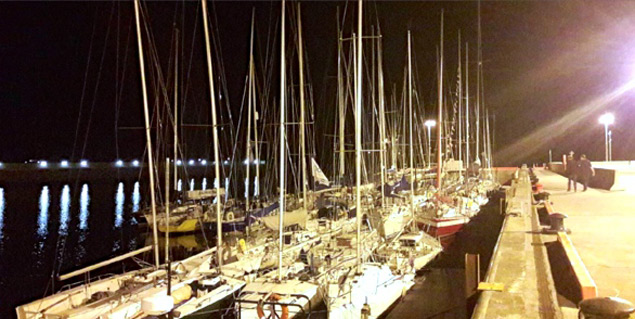 By last night, the full WIORA fleet had assembled at Cill Ronan in the Aran Islands
By last night, the full WIORA fleet had assembled at Cill Ronan in the Aran Islands




























